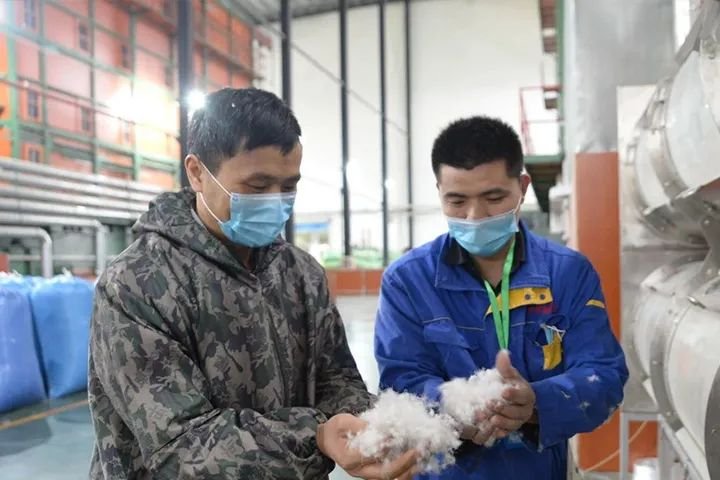Cn-down > Domestic news > News content
2024-09-07 来源:金绒 浏览量:1294
Market Summary
In the 36th week of 2024 (9.2-9.8), the market was generally stable, with duck down prices rising slightly.

Down prices had a good start in September. Recently, due to the shortage of duck supply and the avoidance of parking by slaughterhouses, the supply of raw duck feathers has been reduced, which has affected the market trend of the entire down market and aggravated the tension in the downstream market in the short term.
In order to relieve the cost pressure brought by the price increase, the market demand for grey duck down has begun to increase. However, goose down is still unsalable, and as goose factories in Northeast China gradually enter the slaughtering season, more high-quality white goose feathers will enter the market in batches, impacting the existing market.
Due to the depression of economic fundamentals, the peak season for down products is not strong this year, but down is a winter essential product, and its market will be affected by weather changes. Recently, the El Nino index has been below the threshold of 0.5 for a long time, and the La Nina phenomenon has continued for some time.
Good News This Week
In the production workshop of a down product company in Huai'an, Jiangsu, a five-compartment hair-sorting machine is separating the raw materials into different grades of hair. The person in charge of the company said that the hair from the first compartment is provided to badminton manufacturers, the hair from the second and third compartments is provided to the home textile industry, and the hair from the fourth and fifth compartments, which generally have a down content of more than 90%, will be sold to down jacket manufacturers.
Due to the growth of downstream demand, down is generally in short supply and prices are rising. The person in charge Zhou Yuhai said: "Due to the high price of raw materials, we basically produce according to orders. The price of goose down with a down content of 90% has increased from 650,000 yuan/ton at that time (November 2022) to 1.3 million yuan/ton now."
Down prices are rising, and consumers are demanding a higher down content in down jackets, further increasing costs. At a down jacket manufacturer in Jiaxing, Zhejiang, workers are rushing to fill orders for down jackets this winter. The person in charge said that in previous years, the filling volume of a down jacket was between 100 and 200 grams, but this year the filling volume of many products has reached 300 grams.

Zhu Lanyue, the person in charge, said: "We use about 20 tons of down a year. Since the beginning of this year, the price of duck down has risen from 390,000 yuan per ton to the current 540,000 yuan per ton. We have to spend at least 4 to 5 million yuan more."
We learned from many companies that the wholesale price of finished down jackets is currently between 200 and 500 yuan, with a general increase of about 10%. This year, the orders of companies are generally good, and they are all increasing production.
Qian Ke, head of a down jacket manufacturer in Zhejiang, said: "At this time last year, we had about 50,000 orders. So far this year, we have received more than 100,000 orders."
source | 央视网
At a meat duck breeding base in Huaiyin, Jiangsu, farmer Hu Sulong said that although it is hot weather now, some ducklings will still die due to the low temperature, so coal is needed for heating. Slightly older meat ducks will get sick and die due to the high temperature, so the ventilation needs to be kept unobstructed at all times, so the cost of raising ducks is relatively high.
Hu Sulong said: "Electricity, heating, labor, medicine, etc., cost about a little over one yuan per duck. After deducting the cost, the profit of a duck is only 1.5 to 2 yuan. That's the most I can make."
Hu Sulong introduced that he signed an agreement with the slaughtering company, in which the company is responsible for providing ducklings, feed and meat duck recycling, while he is responsible for the breeding link. One greenhouse can breed 7,000 ducklings with a growth cycle of about 40 days. Ducks can be marketed seven times a year, and the annual profit of a greenhouse is about 100,000 yuan.

Since most local farmers have signed contracts with slaughterhouses and have a close relationship with them, their willingness to breed is relatively stable. The number of local meat ducks in the pen has basically not fluctuated significantly. As for slaughterhouses, due to the sharp rise in down prices, many slaughterhouses have begun to add or expand down primary processing production lines to increase profits.
In a slaughterhouse in Xuyi, Jiangsu, rows of meat ducks are being unloaded from trucks and sent to the slaughtering line. The feathers in the plucking machine will flow to the down primary processing workshop. After simple washing and drying, they can be packaged.
Liu Guangqiang, head of a duck slaughtering company in Jiangsu, said: "We now slaughter about 40,000 ducks a day, and we can produce about 70 bags of down every day. Each bag of down weighs about 45 kilograms, which means we produce about 3.1 tons of down every day. According to the current market price, we can make a profit of about 180,000 yuan a day."
Data shows that from the beginning of this year to August 25, the number of newly registered wool primary processing enterprises nationwide was 5,114, a year-on-year increase of 35%.
source | 央视网
Recently, Huaying Agriculture stated in a conference call with institutional investors that the price of meat ducks has continued to decline since the second quarter of last year and has been running at a low level since 2024. In the second half of this year, with the arrival of the traditional peak season, the recovery of holiday and tourism consumption demand, and the fact that live pig prices may maintain the current profit level, it is expected that the price of meat ducks will rise in the second half of the year.
In terms of down, the prices of various specifications of down have risen to varying degrees since 2023, and the price increase has been more obvious in the first half of this year. The current round of sharp rise in down prices is mainly driven by the growth of downstream demand and the increase in awareness of down products.
At the same time, the price of down is generally affected by many factors, including downstream demand, duck slaughter volume, weather, cotton prices, etc. Although the price of down has loosened recently, it is expected that the price of down will not fluctuate too much in the future.

In terms of operations, first, through project investment, we will effectively expand the existing production capacity; second, through continuous research and development and innovation, we will provide stable, reliable and high-quality raw materials and value-added services to high-quality customers at home and abroad, and cut into the customer supply chain. At the same time, on the basis of identifying and avoiding risks, we will establish overseas operating entities, carry out overseas layout of down processing and warehousing, and continuously improve the service level for overseas customers.
The company will continue to optimize the layout of the down industry and seek new profit growth points. This year, the company introduced a Hangzhou Xiaoshan company that has been making down clothing for more than 20 years to its Huangchuan headquarters. The company has certain industrial, technical, brand and sales advantages and has established a joint venture company, which is mainly engaged in the down products business.
In response to the question "the company's down business has grown rapidly in the first half of this year. Has it considered acquiring minority shareholders' equity to expand its profit scale?", Huaying Agriculture replied that the company has contacted the minority shareholders of the down business holding subsidiary on relevant matters. If any information disclosure matters are involved in the future, the company will fulfill its information disclosure obligations in a timely manner in accordance with regulatory rules.
source | 华英农业、证券时报
Low production, low inventory, high seedling prices, market shortages, continuous rise in pork prices, ban on poultry imports... You only need to choose two or three of these labels, which would definitely be associated with price increases in previous years. If all of them were met at the same time, it would be a big increase. However, this year, we did not see the expected market conditions, and the price per ton of large white-striped ducks did not even exceed ten thousand yuan.
In fact, this year the prices of feed raw materials including corn and soybean meal have shown a significant decline. Coupled with the increase in duck feather prices, the overall selling price of meat ducks has been partially increased, making slaughtering companies generally profitable.
However, on the one hand, the production of large white-striped ducks has not been particularly sufficient this year, and manufacturers and distributors do not have much inventory at the moment, so there is little significance in raising prices; on the other hand, in the context of a sluggish market, price increases will affect the profits of distributors and terminal merchants, and in the long run may force them to change their product structure, which is not conducive to the future development of the industry.

Therefore, although the industry has made less money in the short term, it has ensured the industry's digestion channels for a period of time in the future. It is a responsible attitude towards the industry to increase when it should increase and stabilize when it should stabilize. And with the start of the school year in September and the approaching Mid-Autumn Festival and National Day, the industry still has certain positive factors.
In terms of pig products, pork prices fluctuated upward in July and August, and it is expected that prices may remain high in September due to the tightening of overall supply. In terms of chicken products, the chicken product market experienced a significant fluctuation in July and August due to the impact of the Brazilian avian influenza incident, but the current price-cutting sentiment in the distribution link is strong. Slaughterhouses have actually fallen into a loss-making state due to the increase in inventory, and prices should be adjusted steadily in September.
Based on the above information, duck products may not rise in the peak season and not fall in the off-season in September this year, and the market should remain relatively stable. In this case, dealers will find it difficult to earn dividends from market fluctuations, but they will also reduce some risks.
source | 佳合食品集团
Bad News This Week
On September 3, data released by the U.S. Institute for Supply Management (ISM) showed that the U.S. ISM manufacturing index shrank for five consecutive months in August, the 21st time of contraction in the past 22 months, but the pace of contraction slowed in August and the index rebounded slightly.
In August, the US ISM Manufacturing PMI index rose by 0.4 points to 47.2 (50 is the dividing line between prosperity and contraction). In March, the US ISM Manufacturing Index unexpectedly reached 50.3, ending 16 consecutive months of manufacturing contraction, but in the following months, the expansion achieved in a single month was only short-lived.
In terms of important sub-indices, the new order index was still in the contraction range, recording 44.6, down 2.8 from July. The production index was 44.8, down 1.1 from the previous month; the price index was 54, up 1.1 from the previous month; the order backlog index was 43.6, up 1.9 from the previous month; the employment index was 46, up 2.6 from the previous month; the new export order index was 48.6, down 0.4 from the previous month; the inventory index was 50.3%, up 5.8 from the previous month.

As the first important US economic indicator released in September, the US ISM manufacturing PMI data for August has attracted much attention from the market. Analysts pointed out that US manufacturing employment continued to shrink, but the pace slowed down, but the overall trend still showed that manufacturing activities were sluggish, triggering market concerns about a US economic recession.
In the August report, five of the 18 industries showed an increase in activity, namely: "primary metals", "petroleum and coal products", "furniture and related products", "food, beverages and tobacco products" and "computers and electronic products"; 12 industries reported a contraction in activity, including the textile industry.
The Apparel, Leather and Related Products (including Down Products) industry reported no changes in new orders, production, employment, supplier deliveries, inventory, customer inventory, backlogs, new export orders, and imports, while raw material prices fell. This suggests that the industry is relatively stable in the short term.
source | ISM
On August 31, data released by the National Bureau of Statistics showed that China's official manufacturing PMI (Purchasing Managers' Index) was 49.1% in July, down 0.3 percentage points from the previous month (the same below), and the manufacturing industry's business climate declined slightly.
In terms of enterprise size, the PMI of large enterprises was 50.4%, down 0.1 percentage point from the previous month, but still above the critical point; the PMI of medium and small enterprises was 48.7% and 46.4% respectively, down 0.7 and 0.3 percentage points from the previous month. The production and operation pressure of small and medium-sized enterprises has increased.
From the perspective of classification indexes, among the five classification indexes that constitute the manufacturing PMI, the production index, new order index, raw material inventory index, employee index and supplier delivery time index are all below the critical point.

Among them, the production index was 49.8%, down 0.3 percentage points from the previous month and below the critical point, indicating that the production activities of manufacturing enterprises have slowed down; the new order index was 48.9%, down 0.4 percentage points from the previous month, indicating that the market demand for manufacturing has declined. Both the production and market demand of manufacturing enterprises have slowed down.
In addition, the raw materials inventory index was 47.6%, down 0.2 percentage points from the previous month, indicating that the inventory of major raw materials in the manufacturing industry decreased compared with the previous month; the employment index was 48.1%, down 0.2 percentage points from the previous month, indicating that the employment climate of manufacturing enterprises has declined; the supplier delivery time index was 49.6%, up 0.3 percentage points from the previous month, indicating that the delivery time of raw material suppliers in the manufacturing industry continued to extend.
Senior statistician Zhao Qinghe believes that affected by factors such as recent high temperatures and heavy rains and the off-season for some industries, the manufacturing PMI fell to 49.1% in August, and the level of economic prosperity has declined.
source | 国家统计局
News Situation
This week's news has more positives than negatives.
Faced with the sharp increase in the price of down raw materials, down manufacturing companies have effectively responded to the challenge of rising costs through strategies such as refined wool separation and production-to-order production. At the same time, they have seized the opportunity of growing downstream demand and achieved a significant increase in order volume.
Through close cooperation with slaughterhouses, farmers have stabilized their income and promoted slaughterhouses to add wool primary processing production lines. This cooperation model not only increases the added value of the industrial chain, but also drives the rapid development of the wool primary processing industry.
In late August, the price of white-feathered ducks did not rise as expected, but due to multiple factors, especially the rise in duck feather prices, the overall selling price of ducks increased, making slaughtering companies generally profitable. The industry remains profitable, and the future market is expected to be relatively stable.
 热门排行
中国三大羽绒生产基地之—广东吴川
全球最奢侈羽绒服排行
一件羽绒服需要多少只鸭子的羽绒?
飞丝是什么?能代替羽绒?别被骗了,三种方法让你告别假羽绒服!
2017羽绒原料价格一路上涨,究竟为何?
你的羽绒服为什么钻绒?涨知识了
羽绒被的价格一般是多少 通过成本看羽绒被价格
中国羽绒服四大品牌调查:到底谁才是最强王者?
羽绒金网:羽毛、羽绒、毛绒计价
《羽绒羽毛》、《羽绒羽毛检验方法》新版标准发布,2017年7月1日实施
热门排行
中国三大羽绒生产基地之—广东吴川
全球最奢侈羽绒服排行
一件羽绒服需要多少只鸭子的羽绒?
飞丝是什么?能代替羽绒?别被骗了,三种方法让你告别假羽绒服!
2017羽绒原料价格一路上涨,究竟为何?
你的羽绒服为什么钻绒?涨知识了
羽绒被的价格一般是多少 通过成本看羽绒被价格
中国羽绒服四大品牌调查:到底谁才是最强王者?
羽绒金网:羽毛、羽绒、毛绒计价
《羽绒羽毛》、《羽绒羽毛检验方法》新版标准发布,2017年7月1日实施
 推荐阅读
“吴川力量”助中国羽绒接轨世界
中国三大羽绒生产基地之—广东吴川
中羽协第二期新国标培训班 在“羽绒之乡”广东吴川成功举办
羽绒之乡:贵港桥圩镇将打造旅游休闲特色小镇
广西贵港桥圩镇:打造中国羽绒休闲旅游特色小镇
羽绒金网:羽毛、羽绒、毛绒计价
羽绒别急着收 中央气象台发布寒潮蓝色预警 部分地区降温超12℃
上海消保委检测 千元鹅绒被用鸭毛绒填充
冻哭丨降温10℃!鸡年首个寒潮预警来袭,你准备好了吗?
传统羽绒产业如何实现转型升级?四川玉泉镇产业集群发展
推荐阅读
“吴川力量”助中国羽绒接轨世界
中国三大羽绒生产基地之—广东吴川
中羽协第二期新国标培训班 在“羽绒之乡”广东吴川成功举办
羽绒之乡:贵港桥圩镇将打造旅游休闲特色小镇
广西贵港桥圩镇:打造中国羽绒休闲旅游特色小镇
羽绒金网:羽毛、羽绒、毛绒计价
羽绒别急着收 中央气象台发布寒潮蓝色预警 部分地区降温超12℃
上海消保委检测 千元鹅绒被用鸭毛绒填充
冻哭丨降温10℃!鸡年首个寒潮预警来袭,你准备好了吗?
传统羽绒产业如何实现转型升级?四川玉泉镇产业集群发展